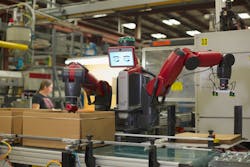In the world of automation technology, the past few years have been dominated by system and device communications and interoperability—from industrial Ethernet and wireless to mobility and the Internet of Things. Considering the significant advances that have been made in this area in both greenfield and brownfield manufacturing facilities, along with the growing rate of adoption (see results from our most recent Ethernet and Wireless in the Plant survey), I don't see any reduction in interest in these technologies in the near term.
However, over the past year or so, I’ve noticed an increasing amount of news coming out of the robotics sector. Most recently, I learned of a major investment in Rethink Robotics by GE Ventures, Goldman Sachs, Bezos Expeditions and a host of other investment firms. Those firms have allotted $26.6 million in financing to Rethink Robotics, bringing the company’s total funding to more than $100 million since 2008.
“Our new and existing investors recognize the enormous market potential for smart, collaborative robots in manufacturing,” says Scott Eckert, president and CEO of Rethink Robotics.
Industry factors behind these new investments, Eckert says, are being driven by the fact that more “manufacturers are rapidly changing the way they do business, prioritizing flexibility and the ability to turn on a dime when demand or direction changes. Smart, collaborative robots that can move between tasks seamlessly and have the ability to operate in a variable manufacturing environment are critical tools enabling our customers to create the factories of the future.”
Backing up Eckert’s comments, George Lee, co-chairman of the global technology, media and telecom group and CIO for the investment banking division of Goldman Sachs, notes that “the business of manufacturing is changing more rapidly today than at any time in recent history [and] smart, collaborative robotics have proven to be a significant and disruptive technology.”
A recent example of a collaborative robot deployment we’ve covered is Schneider Electric’s use of Rethink Robotics’ Baxter robot at its plant in Columbia, Mo.
The investments being made in robotics technology are supported by recent research from PMMI (disclosure: PMMI is the parent company of Automation World). In its 2014 Trends in Robotics Market Assessment report, PMMI pointed out that, in its 2008 robotics report, 1 in 5 manufacturing locations used robots and manufacturers and OEMs predicted that robotic usage would nearly double by 2013. Calculating industry data over that time period showed that actual results outpaced industry predictions, with the use of robotics on processing and packaging lines, for example, having more than tripled between 2008 and 2013.
In PMMI’s 2014 report, 1 in 5 of the manufacturing locations surveyed say they do not plan to use robotic technology in their facilities in the next 12 months. However, 82 percent of manufacturing locations predict that they will be operating robots on the plant floor in the next 5 years. This segment encompasses current users (72 percent) and first-time purchasers (10 percent).
The reasons behind the recent uptick in robotic deployments in manufacturing, according to the PMMI report, include advancements in vision, programming, software and end-of-arm tooling (EOAT) technology that allow robots to be more flexible and capable of moving heavy objects (such as kegs of beer) as well as handling delicate products and packaging materials (such as snack food bags).
One of the most significant robot-related trends in the food industry is the Food and Drug Administration (FDA) approval of washdown robots and EOAT for use in direct food contact. According to the PMMI report, “a washable robot has smooth surfaces that prevent food particles from gathering on the surface and an EOAT that can be chemically sanitized to make it aseptically clean. With the approval of washdown robots for food handling, robots are poised to quickly move upstream to processing and primary packaging operations.”
Many of the reasons cited in the PMMI report for the increased interest in robotics are addressed by Rethink Robotics’ Baxter which, with its various EOAT options, can be used in kitting, packaging, loading/unloading, machine tending and materials handling applications.
The promotional video below from Rethink Robotics highlights how Baxter is being used in collaborative robot/human operations at Praxis Packaging.

